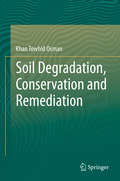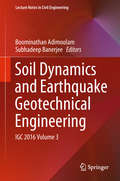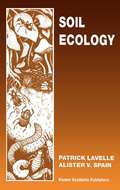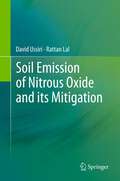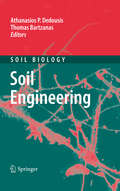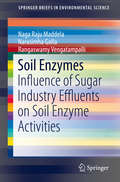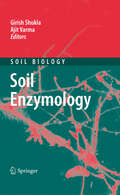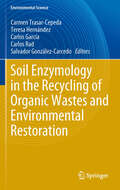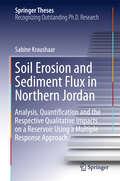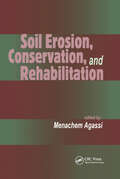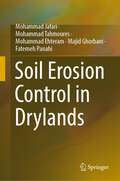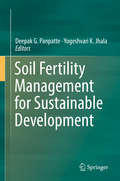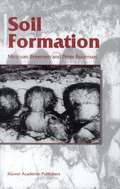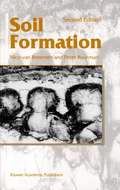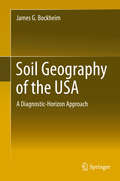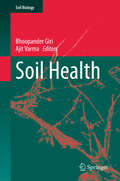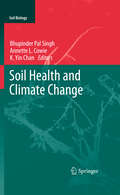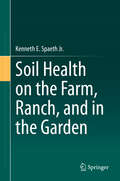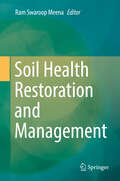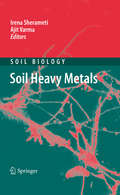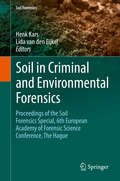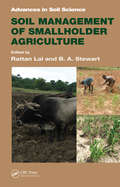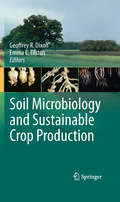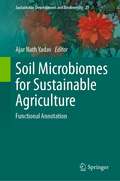- Table View
- List View
Soil Degradation, Conservation and Remediation
by Khan Towhid OsmanIn view of the grave consequences of soil degradation on ecosystem functions, food security, biodiversity and human health, this book covers the extent, causes, processes and impacts of global soil degradation, and processes for improvement of degraded soils. Soil conservation measures, including soil amendments, decompaction, mulching, cover cropping, crop rotation, green manuring, contour farming, strip cropping, alley cropping, surface roughening, windbreaks, terracing, sloping agricultural land technology (SALT), dune stabilization, etc., are discussed. Particular emphasis is given to soil pollution and the methods of physical, chemical and biological remediation of polluted soils. This book will lead the reader from the basics to a comprehensive understanding of soil degradation, conservation and remediation.
Soil Dynamics and Earthquake Geotechnical Engineering: IGC 2016 Volume 3 (Lecture Notes in Civil Engineering #15)
by Boominathan Adimoolam Subhadeep BanerjeeThis book gathers selected proceedings of the annual conference of the Indian Geotechnical Society, and covers various aspects of soil dynamics and earthquake geotechnical engineering. The book includes a wide range of studies on seismic response of dams, foundation-soil systems, natural and man-made slopes, reinforced-earth walls, base isolation systems and so on, especially focusing on the soil dynamics and case studies from the Indian subcontinent. The book also includes chapters addressing related issues such as landslide risk assessments, liquefaction mitigation, dynamic analysis of mechanized tunneling, and advanced seismic soil-structure-interaction analysis. Given its breadth of coverage, the book offers a useful guide for researchers and practicing civil engineers alike.
Soil Ecology
by P. Lavelle A. SpainA number of excellent textbooks on general ecology are currently available but‚ to date‚ none have been dedicated to the study of soil ecology. This is important because the soil‚ as the ‘epidermis’ of our planet‚ is the major component of the terrestrial biosphere. In the present age‚ it is difficult to understand how one could be interested in general ecology without having some knowledge of the soil and further‚ to study the soil without taking into account its biological components and ecological setting. It is this deficiency that the two authors‚ Patrick Lavelle and Alister Spain‚ have wished to address in writing their text. A reading of this work‚ entitled ‘Soil Ecology’‚ shows it to be very complete and extremely innovative in its conceptual plan. In addition‚ it follows straightforwardly through a development which unfolds over four substantial chapters. Firstly‚ the authors consider the soil as a porous and finely divided medium of b- organomineral origin‚ whose physical structure and organisation foster the development of a multitude of specifically adapted organisms (microbial communities‚ roots of higher plants‚ macro-invertebrates).
Soil Emission of Nitrous Oxide and its Mitigation
by David Ussiri Rattan LalNitrous oxide gas is a long-lived relatively active greenhouse gas (GHG) with an atmospheric lifetime of approximately 120 years, and heat trapping effects about 310 times more powerful than carbon dioxide per molecule basis. It contributes about 6% of observed global warming. Nitrous oxide is not only a potent GHG, but it also plays a significant role in the depletion of stratospheric ozone. This book describes the anthropogenic sources of N2O with major emphasis on agricultural activities. It summarizes an overview of global cycling of N and the role of nitrous oxide on global warming and ozone depletion, and then focus on major source, soil borne nitrous oxide emissions. The spatial-temporal variation of soil nitrous oxide fluxes and underlying biogeochemical processes are described, as well as approaches to quantify fluxes of N2O from soils. Mitigation strategies to reduce the emissions, especially from agricultural soils, and fertilizer nitrogen sources are described in detail in the latter part of the book.
Soil Engineering (Soil Biology #20)
by Athanasios P. Dedousis Thomas BartzanasThe agricultural world has changed significantly during the last years. The excessive use of heavy machinery, waste disposal, the use of agrochemicals and new soil cultivation means led to severe problems, which agricultural engineers have to cope with in order to prevent soil from permanent irreversible damage. This Soil Biology volume will update readers on several cutting-edge aspects of sustainable soil engineering including topics such as: soil compaction, soil density increases, soil disturbance and soil fragmentation; soil tillage machineries and optimization of tillage tools; soil traffic and traction, effects of heavy agricultural machines, the use of robotics in agriculture and controlled traffic farming; mechanical weed control, the characterization of soil variability and the recycling of compost and biosolids in agricultural soils.
Soil Enzymes: Influence of Sugar Industry Effluents on Soil Enzyme Activities (SpringerBriefs in Environmental Science)
by Naga Raju Maddela Narasimha Golla Rangaswamy VengatampalliThis book addresses issues arising from discharge of effluents from sugar industry on to surrounding land or into a water body such as physicochemical properties of soil, changes in the micro flora, quantification of soil enzyme activities as influenced by effluents. Disposal of effluents without neutralization has become general practice. These effluents are chemically heterogeneous, contain organic and inorganic pollutants including, sugar baggage, molasses, carbonates, bicarbonates. The impact of sugar industry effluents on microbial activities in terrestrial ecosystem is scanty. There is also significant interest in the study of soil enzymes because such effect reflects the potential capacity of a soil to perform certain biological transformation of soil fertility.
Soil Enzymology (Soil Biology #22)
by Girish Shukla and Ajit VarmaSoil enzymes are one of the vital key mediators involved in nutrient recycling and the decomposition of organic matter and thereby in maintaining soil quality and fertility. This Soil Biology volume covers the various facets of soil enzymes, such as their functions, biochemical and microbiological properties and the factors affecting their activities. Enzymes in the rhizosphere, in forest soils, and in volcanic ash-derived soils are described. Soil enzymes covered include phosphohydrolases, lignocellulose-degrading enzymes, phenol oxidases, fungal oxidoreductases, keratinases, pectinases, xylanases, lipases and pectinases. Several chapters treat the soil enzymatic activities in the bioremediation of soils contaminated with pesticides and pollutants such as oil, chlorinated compounds, synthetic dyes and aromatic hydrocarbons. The role of soil enzymes as bioindicators is a further important topic addressed.
Soil Enzymology in the Recycling of Organic Wastes and Environmental Restoration (Environmental Science and Engineering)
by Carmen Trasar-Cepeda, Teresa Hernández, Carlos García, Carlos Rad and Salvador González-CarcedoSoil enzymes play a fundamental role in many soil processes such as the mineralization of organic matter, the synthesis of humic substances, the degradation of xenobiotics or the mechanisms involved in the biocontrol of plant pathogens. Their direct link with soil microorganisms gives them a key role as biomonitors of the evolution of soil quality or in the monitoring of the application of organic amendments to degraded soils. As a consequence of the importance of soil enzymes on soil processes, there is an increasing interest in their study, as well as in the application of molecular techniques as diagnostic tools.
Soil Erosion and Sediment Flux in Northern Jordan: Analysis, Quantification and the Respective Qualitative Impacts on a Reservoir Using a Multiple Response Approach (Springer Theses)
by Sabine KraushaarThis book combines new quantitative erosion measurement methods with a geochemical fingerprint and a model-based approach to measure erosion and sediment flux in the Wadi Al-Arab, a Mediterranean to semi-arid catchment in northwest Jordan. The outcomes reveal the local importance of soil erosion and sediment yield in connection with sedimentation and pollution of surface water bodies, propose managed aquifer recharge strategies that focus on in-channel constructions, and can be used to support local soil management strategies.In Jordan, one of the most water scarcity-affected countries in the world, erosion and sedimentation negatively impact integrative water resource management projects, such as water reservoirs and groundwater recharge basins. This book combines a multiple-response approach with new qualitative methods, such as olive mound measurements and OSL dating of Roman cistern sediments, to obtain long-term average erosion rates in the Mediterranean to semi-arid Wadi Al-Arab catchment in northwest Jordan. The implementation and enhancement of a geochemical sediment fingerprint of the reservoir sediments helped to provide new insights on sediment connectivity. Lastly, the outcomes were compiled and tested in the SedNet model, which provides a more holistic view of the results at the catchment scale and can effectively complement local management strategies.
Soil Erosion, Conservation, and Rehabilitation
by Agassi,Discusses the latest information regarding the processes and mechanisms responsible for runoff and erosion by water in arable lands--detailing state-of-the-art water and soil conservation methods. Elucidates the rehabilitation of agricultural lands depleted by human activity.
Soil Erosion, Conservation, and Rehabilitation
by Agassi,Discusses the latest information regarding the processes and mechanisms responsible for runoff and erosion by water in arable lands--detailing state-of-the-art water and soil conservation methods. Elucidates the rehabilitation of agricultural lands depleted by human activity.
Soil Erosion Control in Drylands
by Mohammad Jafari Mohammad Tahmoures Mohammad Ehteram Majid Ghorbani Fatemeh PanahiThis book focuses on drylands such as arid, semi-arid and dry sub-humid areas where they form the main part of ecosystems, e.g., in Iran, but also around the world. Mismanagement and improper exploitation of these areas lead to more degradation day by day. Besides an introduction to the role and importance of vegetation cover in conserving soil against wind and water erosion, this book gives a scope of appropriate techniques and methods for vegetation establishment and maintenance, indicators for suitable plants selection for soil conservation, and soil erosion prevention and combat. It provides methods of soil erosion prevention and combating through the application of plants, using bioengineering systems for soil erosion control and the role of agroforestry in soil erosion prevention. This book can be helpful to those with an interest in countries with similar climates to Iran. In particular, this includes Dubai, Kuwait, Saudi Arabia, Afghanistan, and Pakistan.
Soil Fertility Management for Sustainable Development
by Yogeshvari K. Jhala Deepak G. PanpatteSoil fertility is the backbone of agricultural systems and plays a key role in determining food quantity and quality. In recent decades, soil fertility has decreased due to indiscriminate use of agrochemicals, and nations around the globe are now facing the challenge of increasing food production while sustainably maintaining soil fertility. Written by leading international scientists in the field, this book explores soil fertility management strategies, including agronomic, microbiological and soil-science based strategies. Highlighting the practices that can be incorporated into organic farming and discussing recent advances, it is a valuable resource for researchers wanting to broaden their vision and the scope of their investigations.
Soil Formation
by Nico van Breemen Peter BuurmanSoils form a unique and irreplaceable essential resource for all terrestrial organisms, including man. Soils form not only the very thin outer skin of the earth's crust that is exploited by plant roots for anchorage and supply of water and nutrients. Soils are complex natural bodies formed under the influence of plants, microorganisms and soil animals, water and air from their parent material, i.e. solid rock or unconsolidated sediments. Physically, chemically and mineralogically they usually differ strongly from the parent material, and normally are far more suitable as a rooting medium for plants. In addition to serving as a substrate for plant growth, including crops and pasture, soils play a dominant role in the biogeochemical cycling of water, carbon, nitrogen and other elements, influencing the chemical composition and turnover rates of substances in the atmosphere and the hydrosphere. Soils take decades to millennia to form. We tread on them and do not usually see their interior, so we tend to take them for granted. But improper and abusive agricultural management, careless land- clearing and reclamation, man-induced erosion, salinisation and acidification, desertification, air- and water pollution, and withdrawal of land for housing, industry and transportation now destroy soils more rapidly than they can be formed.
Soil Formation
by Nico van Breemen Peter BuurmanSoil Formation deals with qualitative and quantitative aspects of soil formation (or pedogenesis) and the underlying chemical, biological, and physical processes. The starting point of the text is the process - and not soil classification. Effects of weathering and new formation of minerals, mobilisation, transport, and breakdown or immobilisation of dissolved and suspended compounds are discussed. Soil processes and profiles are discussed in relation to the landscape, the geosphere, and the biosphere. Emphasis lies on the universality of soil-forming processes in past and present, and on the soil as a dynamic entity that forms part of the total environment. Complexity of genetic processes in time and space is given much attention. The text gives many examples from literature and places some in a new light. The reader is guided through the subject matter by a large number of questions and problems to help understand and synthesis the material. Answers to all questions are included. This second edition has been updated to reflect recent discoveries. Printing errors have been corrected, and new photographs support the text.
Soil Geography of the USA: A Diagnostic-Horizon Approach
by James G. BockheimSince 1980, our understanding of the factors and processes governing the distribution of soils on the Earth’s surface has increased dramatically, as have the techniques for studying soil patterns. The approach used in this book relies on the National Resources Conservation Service databases to delineate the distribution of each of the eight diagnostic epipedons and 19 subsurface horizons, to identify the taxonomic level at which each of these horizons is used, to develop an understanding of the role of the factors and processes in their formation and to summarize our latest understanding of their genesis. A chapter is devoted to each diagnostic horizon (or combined horizons). This book is intended to serve as a textbook in soil geography, a reference book for geographers, ecologists and geologists and a tool for soil instructors, landlookers, mappers, classifiers and information technologists.
Soil Health (Soil Biology #59)
by Bhoopander Giri Ajit VarmaThis book gathers the latest insights into soil health and its sustainability, providing an up-to-date overview of the various aspects of soil quality and fertility management, e.g., plant-microbe interactions to maintain soil health; and the use of algal, fungal and bacterial fertilizers and earthworms for sustainable soil health and agricultural production.It first discusses the past, present, and future scenarios of soil health, and then explores factors influencing soil health, as well as the consequences of degradation of soil health for sustainable agriculture. Lastly it highlights solutions to improve and maintain soil health so as to achieve greater productivity and sustainability without damaging the soil system or the environment.Soil health is defined as the capacity of a soil to function within ecosystem frontiers, to sustain biological productivity, to maintain environmental quality and to promote plant, animal and human health. Soil health is established through the interactions of physical, chemical and biological properties, e.g., soil texture, soil structure, and soil organisms. Healthy soil provides adequate levels of macro- and micronutrients to plants and contains sufficient populations of soil microorganisms. As a result of the increasingly intensified agriculture over the past few decades, soils are now showing symptoms of exhaustion and stagnating or declining crop yields. Exploring these developments as well as possible solutions based on holistic and sustainable approaches, this book is a valuable resource for researchers in the area of soil and environmental science, agronomy, agriculture, as well as students in the field of botany, ecology and microbiology.
Soil Health and Climate Change (Soil Biology #29)
by Bhupinder Pal Singh, Annette L. Cowie and K. Yin Chan“Soil Health and Climate Change” presents a comprehensive overview of the concept of soil health, including the significance of key soil attributes and management of soil health in conventional and emerging land use systems in the context of climate change.Starting with a review of the physical, chemical and biological indicators of soil health and their significance for monitoring the impacts of climate change, this book then focuses on describing the role of soil structure, pH, organic matter, nitrogen, respiration and biota in sustaining the basic functions of soil ecosystems, and their anticipated responses to climate change. Further topics include the management of cropping, pastoral, and forestry systems, and rehabilitated mine sites, with a focus on mitigation of and adaptation to climate change impacts. Finally, the opportunities and potential risks of organic farming, biochar and bioenergy systems, and their ability to sustain and even enhance soil health, are discussed.
Soil Health on the Farm, Ranch, and in the Garden
by Kenneth E. Spaeth Jr.This book explores the importance of soil health in croplands, rangelands, pasturelands, and gardens, and presents new methods and technologies for assessing soil dynamics and health in these different land types. Through perspectives of agriculture, soil management, and ecological sustainability, the book provides accurate and up-to-date information on soil health assessment and maintenance that is often missing from current literature on conservation and environmental management and preservation. The book is written in a clear and concise format, and will appeal to non-scientists interested in soil health, as well as professional farmers, ranchers and gardeners. The book begins by discussing soil health from a historical perspective, and in terms of how it is covered in the news currently. Then the author addresses the ecological implications of soil health in farming, ranching and gardening, and comprehensively details the physical, chemical and biological properties of soil as they apply in various land types. The book then examines soil health assessment using new diagnostic and analytic technologies, and how these new innovations will be necessary going forward to maintain and improve soil health.
Soil Health Restoration and Management
by Ram Swaroop MeenaMeeting the food requirements of an ever-increasing population is a pressing challenge for every country around the globe. Soil degradation has a negative impact on food security by reducing the cultivated land areas, while at the same time the world population is predicted to increase to 9.2 billion in 2050. Soil degradation adversely affects soil function and productivity and degraded soils now amount to 6 billion ha worldwide. The major factors are salinization, erosion, depletion of nutrients due to exhaustive agricultural practices and contamination with toxic metal ions and agrochemicals, which reduces the activity of soil microbe. In addition, poor soil management also decreases fertility. As such, measures are required to restore the soil health and productivity: organic matter, beneficial microorganisms and nutrient dynamics can all improve the physical, chemical and biological properties of soil. Understanding the role of soil health restoration and management in sustainability and nutritional security calls for a holistic approach to assess soil functions and examine the contributions of a particular management system within a defined timescale. Further, best management practices in cropping systems are important in ensuring sustainability and food and nutritional security without compromising the soil quality and productivity potential. Rational soil management practices must allow environmentally and economically sustainable yields and restoration of soil health.
Soil Heavy Metals: Monitoring And Remediation (Soil Biology #19)
by Irena Sherameti Ajit VarmaHuman activities have dramatically changed the composition and organisation of soils. Industrial and urban wastes, agricultural application and also mining activities resulted in an increased concentration of heavy metals in soils. How plants and soil microorganisms cope with this situation and the sophisticated techniques developed for survival in contaminated soils is discussed in this volume. The topics presented include: the general role of heavy metals in biological soil systems; the relation of inorganic and organic pollutions; heavy metal, salt tolerance and combined effects with salinity; effects on abuscular mycorrhizal and on saprophytic soil fungi; heavy metal resistance by streptomycetes; trace element determination of environmental samples; the use of microbiological communities as indicators; phytostabilization of lead polluted sites by native plants; effects of soil earthworms on removal of heavy metals and the remediation of heavy metal contaminated tropical land.
Soil in Criminal and Environmental Forensics: Proceedings of the Soil Forensics Special, 6th European Academy of Forensic Science Conference, The Hague (Soil Forensics)
by Henk Kars Lida EijkelThis introductory volume to a new series on Soil Forensics gives a kaleidoscopic view of a developing forensic expertise. Forensic practitioners and academic researchers demonstrate, by their joint contributions, the extent and complexity of soil forensics. their reports exemplify the broad range of sciences and techniques applied in all stages of forensic soil examinations, from investigations at crime scenes to providing evidence that can be used in court proceedings. Moreover the necessity is depicted of co-operation as a condition for any work in soil forensics between scientists of different disciplines, but no less between scientists and law enforcers.Soils play a role in environmental crimes and liability, as trace evidence in criminal investigations and, when searching for and evaluating, buried human remains. This book shows soil forensics as practiced in this legal context, emerging and solidifying in many countries all over the world, differing in some respects because of differences in legal systems but ultimately sharing common grounds.
Soil Management of Smallholder Agriculture
by Rattan Lal B. A. StewartNearly two billion people depend on hundreds of millions of smallholder farmers for food security. Yet, these farmers' lives also hang in the balance due to their extreme vulnerability to the risks of soil degradation and depletion, soil exhaustion, climate change, and numerous biotic and abiotic stresses. Soil Management of Smallholder Agriculture
Soil Microbiology and Sustainable Crop Production
by Geoffrey R. R. Dixon Emma L. L. TilstonSoils into which crop plants root and from which they obtain essential minerals and water contain huge arrays of microbes. Many have highly beneficial effects on crop growth and productivity, others are pathogens causing diseases and losses to yield and quality, a few microbes offer protection from these pathogenic forms and others have little or no effect. These intimate and often complex inter-relationships are being explored with increasing success providing exciting opportunities for increasing crop yields and quality in sustainable harmony with the populations of beneficial soil microbes and to the detriment of pathogens. This book explores current knowledge for each of these aspects of soil microbiology and indicates where future progress is most likely to aid in increasing crop productivity by means which are environmentally benign and beneficial.
Soil Microbiomes for Sustainable Agriculture: Functional Annotation (Sustainable Development and Biodiversity #27)
by Ajar Nath YadavThis book encompasses current knowledge of soil microbiomes and their potential biotechnological application for plant growth, crop yield, and soil health under the natural as well as harsh environmental conditions for sustainable agriculture. The microbes are ubiquitous in nature. The soil is a natural hotspot of the soil microbiome. The soil microbiome plays a critical role in the maintenance of global nutrient balance and ecosystem functioning. The soil microbiomes are associated with plant ecosystems through the intense network of plant–microbe interactions. The microbes present in bulk soil move toward the rhizospheric region due to the release of different nutrients by plant systems. The rhizospheric microbes may survive or proliferate in rhizospheric zone depending on the extent of influences of the chemicals secreted into the soil by roots. The root exudates contain the principal nutrients factors (amino acids, glucose, fructose, and sucrose). The microbes present in rhizospheric region have capabilities to fix atmospheric nitrogen, produce different phytohormones, and solubilize phosphorus, potassium, and zinc. The plant systems take these nutrients for their growth and developments. These soil and plant associated microbes also play an important role in protection of plants from different plant pathogenic organisms by producing different secondary metabolites such as ammonia, hydrogen cyanide, siderophores, and hydrolytic enzymes. The soil microbiomes with plant growth-promoting (PGP) attributes have emerged as an important and promising tool for sustainable agriculture. The soil microbiomes promote the plant growth and enhance the crop yield and soil fertility via directly or indirectly different plant growth-promoting mechanism. The soil microbes help the plant for adaptation in extreme habitats by mitigating the abiotic stress of high/low temperatures, hypersalinity, drought, and acidic/alkaline soil. These PGP microbes are used as biofertilizers/bioinoculants to replace the harmful chemical fertilizers for sustainable agriculture and environments.The aim of the book “Soil Microbiomes for Sustainable Agriculture” is to provide the recent advances in mechanisms of plant growth promotion and applications of soil microbiomes for mitigation of different abiotic stresses in plants. The book is useful to scientists, researchers, and students related to microbiology, biotechnology, agriculture, molecular biology, environmental biology, and related subjects.
